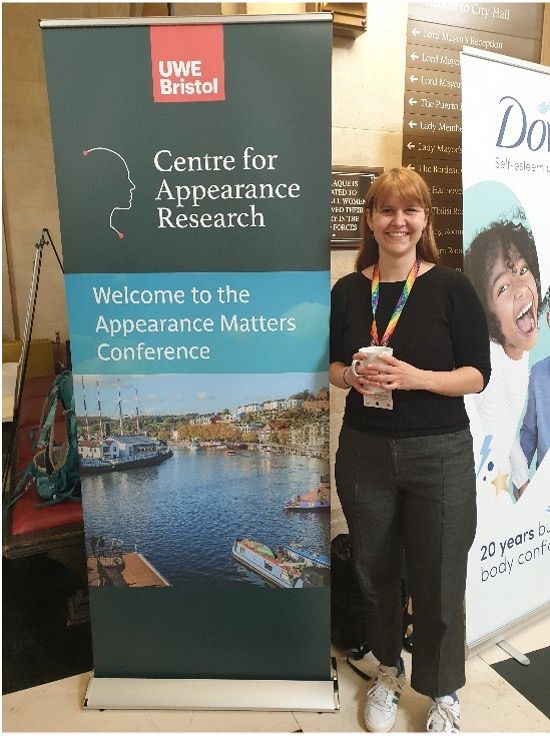Written by Tine Opitz (EDIFY Post-Doc)
COVID has made it difficult to attend any in-person events throughout my research career, so I was excited to get the opportunity to attend Appearance Matter for the very first time this year. Hosted at the City Hall in Bristol, I enjoyed three days of inspiring talks, interesting poster presentations, and numerous networking opportunities. As a conference focusing on both visible differences and body image, I was impressed by the variety of research topics covered, yet, a constant common thread remained visible throughout. I learned about creative methodological approaches using
TikTok algorithms , much-needed new perspectives on the role of
social class ,
cultural differences and
societal norms , and met researchers from all over the world, eager to engage in conversations about how to challenge the status quo, both in terms of existing research approaches as well as the ways in which we can express our own true selves in current sociocultural environments.
Even though I could write pages about all the talks I have attended during this three-day conference (indeed, I have filled pages of my notebook with notes), I will focus on my biggest take-home messages for now, in order to illustrate how conferences can shine light on current views and perspectives that are underlying changing research environments.
1) The need to re-build our research landscape
Research is not a static process. Our approaches need to adapt to different research contexts, the questions we ask, and the people we work with. It is thus not surprising that we have started to challenge the very foundations of research we have built over time. This includes the power dynamics we establish when we design, conduct, and communicate our projects. Reflecting on the current status-quo in research, many talks at Appearance Matters focused on the importance of opening up our minds and methodologies to perspectives that are not reflected within the current research landscape. Be it the way that we design our
scales and
interventions , or the ways in which we represent marginalised groups. The variety of talks on this subject promises change, even though the “Ignite Session” on “Advancing Equality, Diversity and Inclusion” highlighted that more change is needed in the future.
2) The power of collaborations
A topic discussed as part of the first keynote presentation (“From zero to 100 million people: Using cross-sector partnerships, evidence-based strategies and disruptive innovation to improve body image and smash beauty stereotypes”) focused on the role of collaborations with not-for-profit and industry organisations. Phillippa Dietrichs talked about the importance of considering shared values within partnerships, how to use task-shifting and disruptive innovation to progress research impact, and how to handle stakeholder influency. I found it particularly helpful to hear more about the practicalities around industry collaborations, including how to make these mutually beneficial and how to set expectations through contracts (which is very important when it comes to publishing rights!). The potential power of collaborations was further highlighted by talks calling for more policy-research engagement , and collaborative intervention
evaluation approaches . Even though we will have to address the challenges of adding further tasks to our already full workloads, establishing collaborations across contexts will be essential in driving fourth impactful change for our research projects.
3) A new era of research: the use of ‘edutainment’ and social media
The use of more creative methods to disseminate research findings is not new, yet, there are constantly new opportunities available to engage with an audience about mental health-related topics. During a special panel focusing on ‘Beyond the selfie: Can social media influencers shape the appearance diversity landscape?’, influencers and activists illustrated the ways in which they have to navigate the power of representation, while constantly being faced by internet trolls and the risks of commodification, or ‘watering down’, of their messages. Even though the impact of some of the more creative ‘intervention’ approaches are difficult to evaluate, ‘edutainment’ is increasingly used to improve outreach of intervention approaches, including
print and
broadcast media . Seeing all these new approaches being used to address specifically hard-to-reach populations, it will be exciting to see what new creative methods of evaluating their impact, researchers will develop in the future.
After three days of focused attention, I could barely put a string of words together when I left the Bristol City Hall to catch my train. I can honestly say, however, that I have never been so inspired and motivated by a conference as much as I have been after attending Appearance Matters. If you would like to read more about this conference and their organisers, have a look at their website
here.


